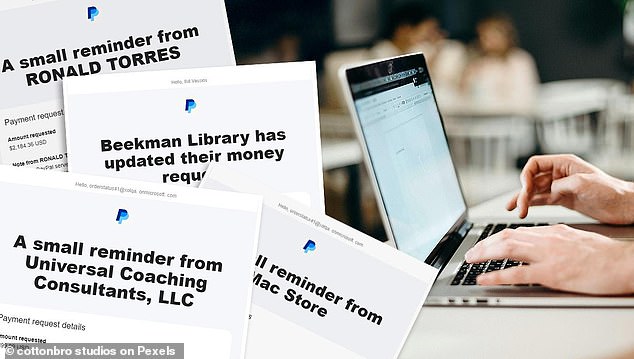Table of Contents
‘Reminder: you still have a request for money!’ That was the subject line of the messages that flooded my husband Barry’s inbox—and those of millions of others—for weeks.
At first, Barry wondered if he had accidentally clicked something. The invoice looked legit: professional logo, a big “Pay Now” button and all. He even hovered his mouse over the sender’s email to double-check himself.
But as the bills kept coming, he knew something was wrong.
“Why are they so persistent?” he asked. That persistence is exactly what scammers are counting on: to freak you out and make you pay.
Barry is not alone. There’s a sneaky scam going around and it looks completely legit because it actually comes through PayPal. Let’s break it down so you don’t fall for it.
Here’s how it works:
First you will receive an invoice via PayPal. For example, it might say something like “Payment due for a purchase” or it might say that a payment was processed due to a technical error.
It looks real because it is sent via the PayPal platform. When you see the familiar logo and format, you can let your guard down.
But it’s a fake invoice. PayPal allows anyone with an account to send an invoice, and scammers abuse this feature to make their schemes appear legitimate.
Millions of Americans are being targeted by a PayPal scam that aims to steal their money
These fake PayPal invoices are convincing. Here’s a quick list of what to look out for:
● Professional PayPal branding: Logos, formatting, and text look clean and legitimate.
● An outstanding payment: The invoice may say something vague, such as “Payment due for technical services,” or refer to a subscription you never signed up for.
● Urgent tone: Scammers like to use phrases like “Immediate action required” to pressure you to respond quickly.
● A support phone number: This is the real pitfall.
The number on the invoice claims to be the contact for PayPal, but takes users to a thief ready to take their money.
All the scam emails I reviewed had different numbers attached.
Calling the fake support number is the worst thing you can do.
The scammer may ask for your login details or payment card details to ‘fix the problem’.
In some cases, they install malware on your device and steal passwords and financial information in the background.
How to recognize and stop it

If you are sure the invoice is fake, delete it and report it to PayPal
PayPal never sends invoices for arbitrary purchases that you have not authorized.
● Check details: View the sender’s email and transaction history. If it’s not a company or person you recognize, it’s probably a scam.
● Double-check the invoice recipient: that’s another glaring red flag. All the emails I saw had someone other than my husband listed in small text at the top.
● Don’t call any of the listed phone numbers: this is smart for any strange bill, call, document, email, text message, whatever. Do not use contact information that is included. To find it, visit the official website.
I looked this up for you: PayPal’s real support number is 1-888-221-1161. They take calls every day from 6am to 6pm PT.
It is best to contact customer service. They are much more familiar with scam patterns than most regular people because they encounter them day in and day out. Additionally, they can look into your account to tell you what is a legitimate request and what is not.
If you are sure the invoice is fake, delete it. But first…
Report it to PayPal. Consider this your good deed for the day. Reporting scams doesn’t just help you, it helps everyone. When you report fake invoices to PayPal, their team can spot patterns, close scammer accounts, and warn others about similar tactics.
● Log in to your PayPal account and go to the Resolution Center, where you can report suspicious invoices.
● Even easier: forward the email to phishing@paypal.com to alert the security team.
Lock your account for extra security
If you don’t have two-factor authentication set up, don’t wait. It only takes a minute. Now you will receive a code when you log in. Annoying? A little. But it’s worth the extra step for any account related to your finances.
● Sign in to your PayPal account in a browser. Click the Settings icon > Security > 2-Step Verification. You can use an authenticator app or receive codes as text messages. Pro tip: An authenticator app is the more secure option.
● Follow the on-screen instructions to complete.
These types of scams are sneaky, but easy to spot if you know what to look for. Share this with your friends and family so they don’t fall for it.


